
Agricultural Machinery Uses In Precision Farming
The use of agricultural machinery has revolutionized farming operations around the world, allowing for large-scale farming as we see today. From GPS-guided tractors to automatic irrigation systems, advancements in agricultural machinery have helped farmers work more efficiently and productively at all levels. When contemporary agricultural equipment is paired with precision farming, the possibilities are expanded to new heights, ensuring a more practical use of resources, enhanced yields, and a minimized environmental footprint. Find out the best ways to incorporate this agricultural machinery and technology into your farm to maximize its efficiency, productivity, and sustainability.
Importance Of Farm Machinery In Agriculture
The introduction of agricultural machinery (agricultural tech) — any kind of mechanical structures, devices, and equipment used in agriculture — is driven by a desire to facilitate farmers’ work and enhance farm productivity. Thanks to advances in agricultural machinery and technologies, farmers now have access to the most effective methods of crop production. When used properly, machinery may tame the most unfit tracts of land and unleash possibilities for the fast and precise cultivation of enormous areas that were previously unthinkable.
With the help of agricultural machinery, more crops can be grown with less labor, time, and cost invested. Moreover, performing the right operations with the right machinery in line with a sustainable farming approach allows for the preservation or even enhancement of the land’s fertility. At the end of the day, farmers who use agricultural equipment wisely benefit from lower labor costs, improved yields, and increased farm profitability.
Benefits Of Using Agricultural Machinery
The employment of agricultural equipment and machinery is crucial to today’s crop production. By making better use of machinery, farmers may cultivate more land more efficiently, increasing yields with less strain on natural resources.
Increased Farm Productivity
Agricultural mechanization has increased farm productivity and overall production for farmers to keep up with the food demand of the world’s expanding population. The intensification of agricultural systems through the use of farm machinery doesn’t come at the price of our natural resources. In addition to helping commercial farmers satisfy food demand through increased yields, agricultural mechanization has the potential to improve rural communities’ livelihoods by enabling the cultivation of higher-quality yields with less physical effort .
Less Understaffing And Reduced Labor Costs
In the past decades, people from the countryside have been increasingly migrating to the cities in search of better job opportunities. But that means farms are often understaffed. How did agricultural machinery change farm labor? With its help, agricultural producers no longer have to worry about understaffing and may save money on labor by not overpaying workers who used to work overtime.
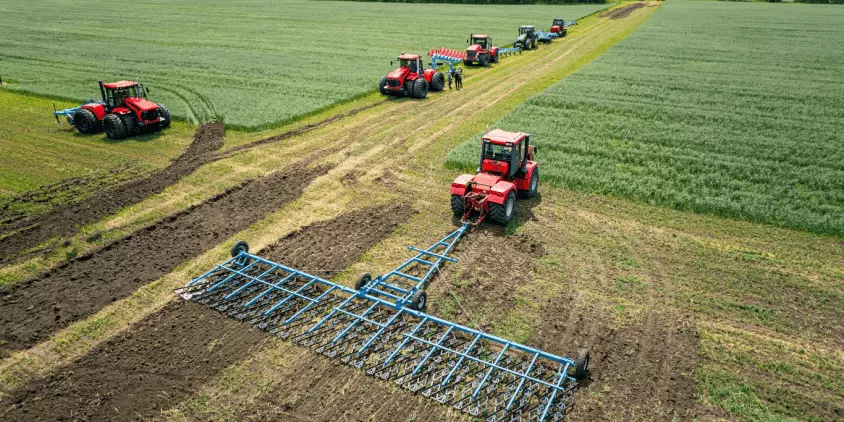
Improved Operation Precision
Sensors integrated into current agricultural machinery and equipment collect essential field data, allowing for smart and accurate crop management. Technological advancements have greatly improved various agricultural processes, enabling the precise application of seeds, water, fertilizer, and pesticides. Thanks to this approach, farmers manage not only to save money but also to reduce their environmental footprint.
Higher Agricultural Earnings
Increased farm incomes can be achieved through the use of agricultural machinery that boosts productivity, optimizes resource allocation, and reduces labor expenses. When farmers have enough money to invest in new agricultural machinery and technology, it starts a positive feedback loop that leads to even more success and progress in the industry.
EOSDA Crop Monitoring
Fields analytics based on high-resolution satellite images to track all the changes on-the-spot!
What Are The Different Types Of Agricultural Machinery?
Crop producers can do a wide range of field operations with more precision and versatility thanks to an assortment of innovative agricultural equipment and attachments. The following categories best describe modern machinery in agriculture.
Equipment For Soil Cultivation And Tillage
These agricultural machinery and equipment reduce the clumps to little pieces and eliminate weeds, resulting in a cleaner and more uniform field surface. They also loosen the soil by turning it over, which makes planting seeds much easier. Among soil cultivation and tillage equipment, the following agricultural machinery stands out:
- cultivators mix the soil and break it down, making well-aerated and weed-free seedbeds;
- cultipackers level planting surfaces by pressing stones into the soil, compacting clumps, and eliminating air pockets;
- plough is agricultural machinery that stirs the soil and buries any unwanted debris, such as weeds or stubble, preparing the field for planting crops;
- rotating tillers break up compacted soil, creating an ideal seedbed for planting seeds;
- harrows improve soil structure by pulverizing it, along with breaking up crop residues and uprooting weeds;
- strip-till aggregates, which combine the advantages of conventional tillage and zero tillage, help to maintain soil structure and reduce erosion.
Planting Equipment
Agricultural machinery for planting loosens the soil, distributes seeds at consistent spacing, and firms the soil afterward. The most common planting machines are:
- seed drills that distribute seeds in furrows at an even rate and depth enable plants to develop uniformly across the field;
- broadcast seeders, or fertilizer spreaders, are agricultural machinery best used for dispersing not only seeds but also lime or fertilizer homogeneously across a field;
- seed cum fertilizer drills deliver seeds and drop fertilizer separately in one drive, ensuring that every plant in the field gets the nutrients it needs.
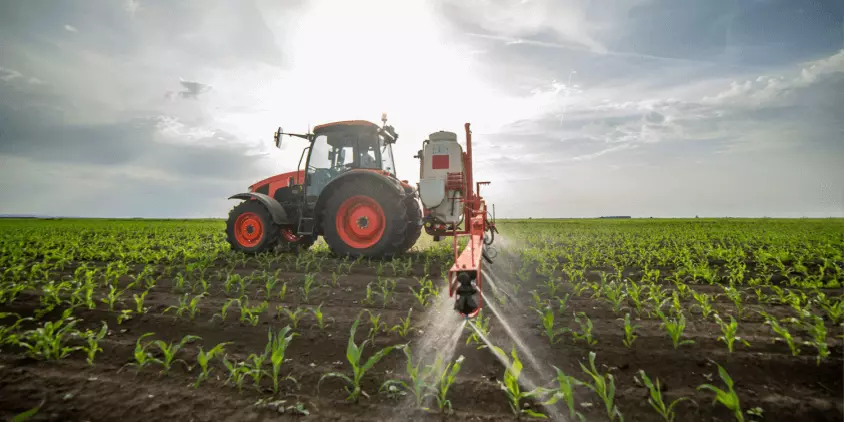
Machinery For Irrigation And Water-Spreading
Irrigation and water-spreading agricultural machinery consists of various hydraulic components, including water intake and pumping equipment, pipes, and other similar apparatus to automate the watering process. Some of the common examples of this agricultural machinery include:
- irrigation equipment includes automated systems that contain pumps, sprinklers, drip lines, and other similar structures and tools to ensure adequate and timely watering of crops;
- center pivot irrigation agricultural machinery is commonly used in large-scale farming to distribute water evenly throughout a field using a sprinkler system that rotates around the pivot point in the field’s center;
- fire sprinkler systems, intended to protect agricultural assets from fire, typically consist of pipes linked to a source of cold water and are automatically activated when a certain temperature is reached.
Fertilizing And Pest Control Machinery
Spreading substances is the primary function of most agricultural and farm machinery in both groups. The key distinction between them is the type of substance for which they are meant. Typical examples of such machinery seen on farms include:
- manure spreaders, also called muck spreaders or honey wagons, are used to distribute manure evenly throughout an agricultural field, adding nutrients to the soil;
- slurry tank, or tanker, is a trailer that includes a tank and a pump to mix solids and liquids, like manure and water, for fertilizing fields sustainably and effectively;
- sprayers make applying liquid inputs (fertilizers, pesticides, and herbicides) to crops much easier and more precise.
Equipment For Harvesting And Threshing
These agricultural machinery and implements are intended for crop harvesting in fields or on preliminary drained irrigated lands. Their versatility extends beyond agriculture; for example, they can be used to harvest grass from a golf course fairway prior to its mowing by a lawn tractor. The following harvesting equipment can be distinguished:
- mowers, manual (hand-pushed) or electric agricultural machinery, are used to cut grass and crops;
- reapers, usually pulled by tractors or tillers, allow for the harvest of grain crops in either dry or wet fields;
- threshers separate grains from stalks and chaffs, giving clean grain without minimal breakage or loss;
- combine harvesters tresh, clean, and deposit the grain in one pass, speeding up the harvesting process;
- grain harvesting machines are designed to harvest beans;
- crop harvesting machines make harvesting and processing crop residue a lot less labor-intensive by cutting crops and compressing hay into bales all at once;
- root crop harvester is a comprehensive agricultural machinery for picking and cleaning root vegetables, extensively used in cultivating garlic, onions, potatoes, carrots, and beetroots;
- vegetable harvesters are typically intended to cater to particular crop varieties such as head vegetables, leafy greens, and herbs;
- conveyor belts are common in agriculture for transferring harvested crops, such as grain or root vegetables, to another point.
Every item of agricultural machinery and equipment already serves a purpose today. And yet, with the help of smart technologies like ground sensors and satellite data, the machinery can be pumped up to its full capacity.
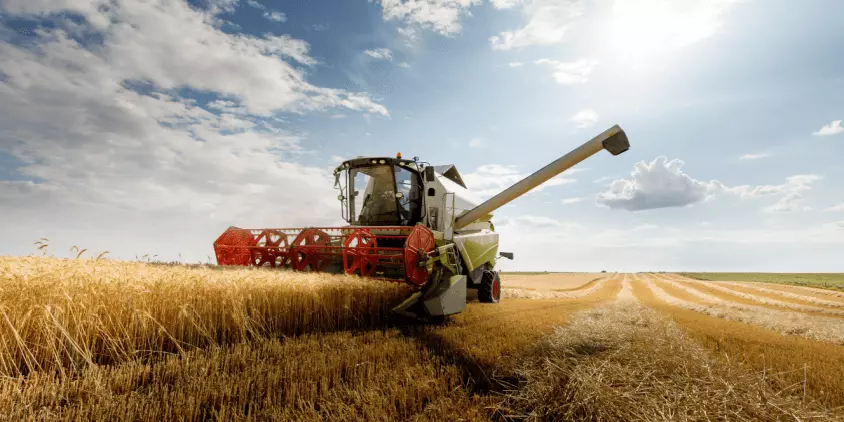
Getting Use Of Smart Agricultural Machinery In Precision Agriculture
Hand-operated agricultural machinery has historically required a lot of human labor as well as solid knowledge and dexterity. Nonetheless, modern farming necessitates accurate operations covering vast swaths of land, and human labor often cannot deliver the precision and efficiency needed for these tasks. Because of this, improving the level of automation and accuracy is the next step in agricultural machinery development. Let’s dig deeper into its most prominent realizations.
Precision Planting
GPS-equipped tractors allow for pinpoint field navigation and complete control over field operations. So, growers can plant with exact row spacing, minimizing gaps and overlap. Modern electronic-controlled seed singulation devices can significantly increase planting productivity and yields while also significantly reducing the inefficiencies of mechanically powered seed metering systems .
To take things a step further, employ satellite technology to conduct variable rate sowing in your fields. With the Multilayer map feature in EOSDA Crop Monitoring, you can effortlessly combine several types of data, such as vegetation indices and elevation data, on a single map, creating a comprehensive tool for agricultural machinery management and optimizing variable rate seeding. The generated map can be imported into your machinery in ISO-XML or SHP formats to make the perfect planting plan a reality.
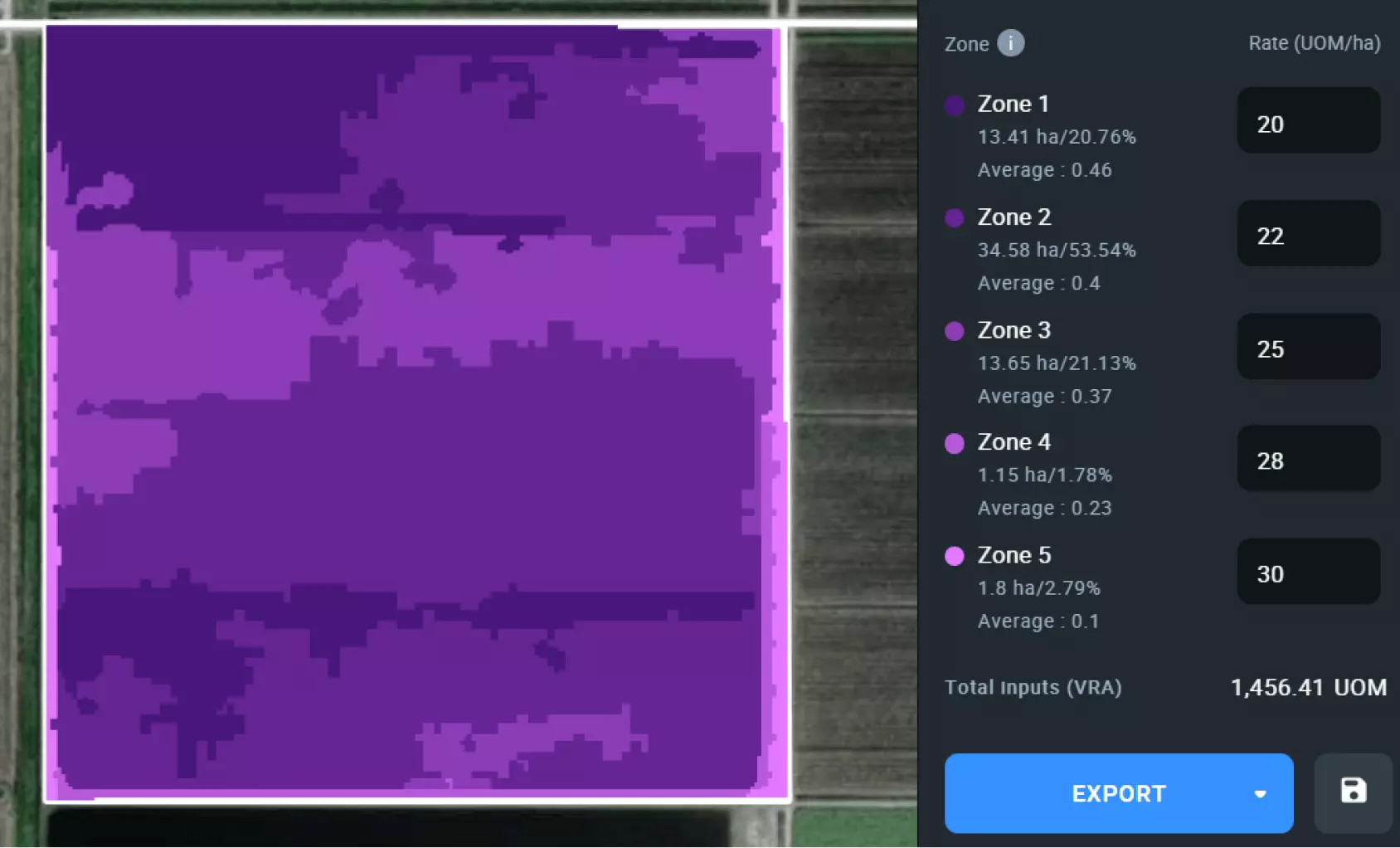
Sensor-Based Precision Irrigation
Sensors mounted on modern tractors monitor various factors like crop health, soil state, and weather conditions. With this data in hand, farmers may make better-informed choices regarding agricultural water management, irrigation, and other farm-related activities. The resulting irrigation precision ensures that crops are watered for maximum growth with minimal waste, creating a win-win situation for farmers and the environment.
With the EOSDA Crop Monitoring platform, you can consolidate all of the data gathered by your equipment from the ground, making it easier to analyze patterns in vegetation state and incorporate them into irrigation decision-making. Data manager allows you to easily link your agricultural machinery to EOSDA Crop Monitoring and effortlessly share data not only on irrigation but also on planting, fertilizing, harvesting, and more. To facilitate analysis, visualize the data collected by your machinery through convenient maps on the platform.

Monitoring Crop Health And Development During The Growing Season
With the use of sensors and GPS tracking technology in planters, smart irrigation systems, and harvesters, farmers can monitor the condition of their crops in real time based on indicators like moisture or chlorophyll levels. Some high-tech machinery for agriculture can work independently, while others are used in combination with GIS (geographic information systems).
Even though the data collected from the field is highly accurate, large-scale farmers may struggle with the need for an overwhelming quantity of smart equipment supporting GIS systems, its high costs, and regular upkeep. In such a situation, satellite imagery and satellite-based GIS platforms are invaluable. They can provide you with equally valid information as specialized agricultural machinery and equipment. Instead of using data from ground sensors, satellite-based platforms rely on space-derived data, refreshed whenever a satellite passes over the field and captures a cloudless image. For example, with only a few clicks in EOSDA Crop Monitoring, a farmer can generate a ReCl (red-edge chlorophyll index) map of their fields. This information allows them to pinpoint areas that could require further monitoring for signs of stress and special attention.
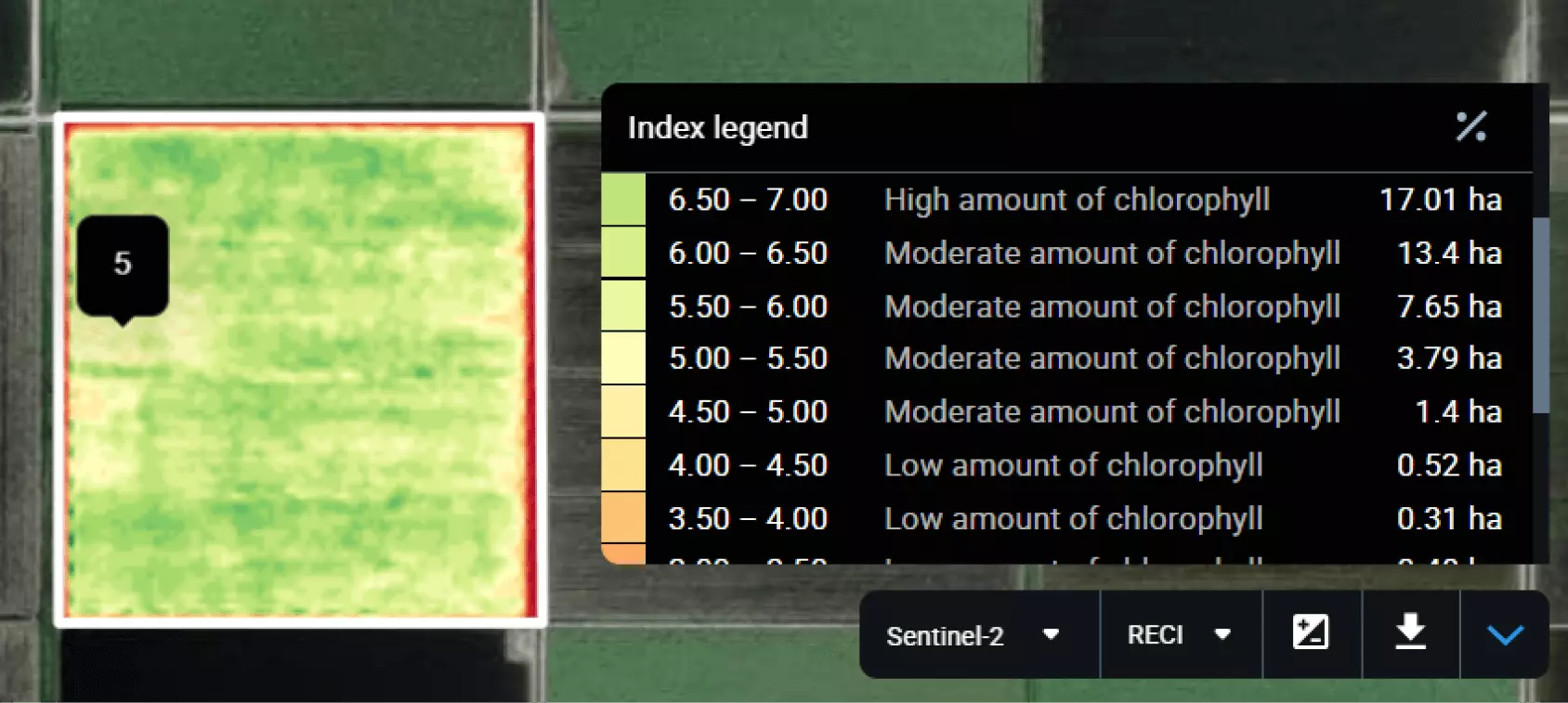
Variable Rate Technology (VRT)
Tractors incorporating variable rate technology in their navigation systems can optimize resource allocation by fine-tuning the input application rates. VRT may use agricultural machinery management data, satellite imagery, or both in VRA (variable rate application) maps. The combination of ground and satellite data allows the highest level of precision in directing the tractor’s application of inputs. VRA maps can, for example, be implemented with EOSDA Crop Monitoring’ space-derived data. Using appropriate maps for each input type helps growers make the most of agricultural inputs such as seeds, fertilizers, and pesticides. This leads to significant cost savings, especially for agricultural producers operating on a large scale.
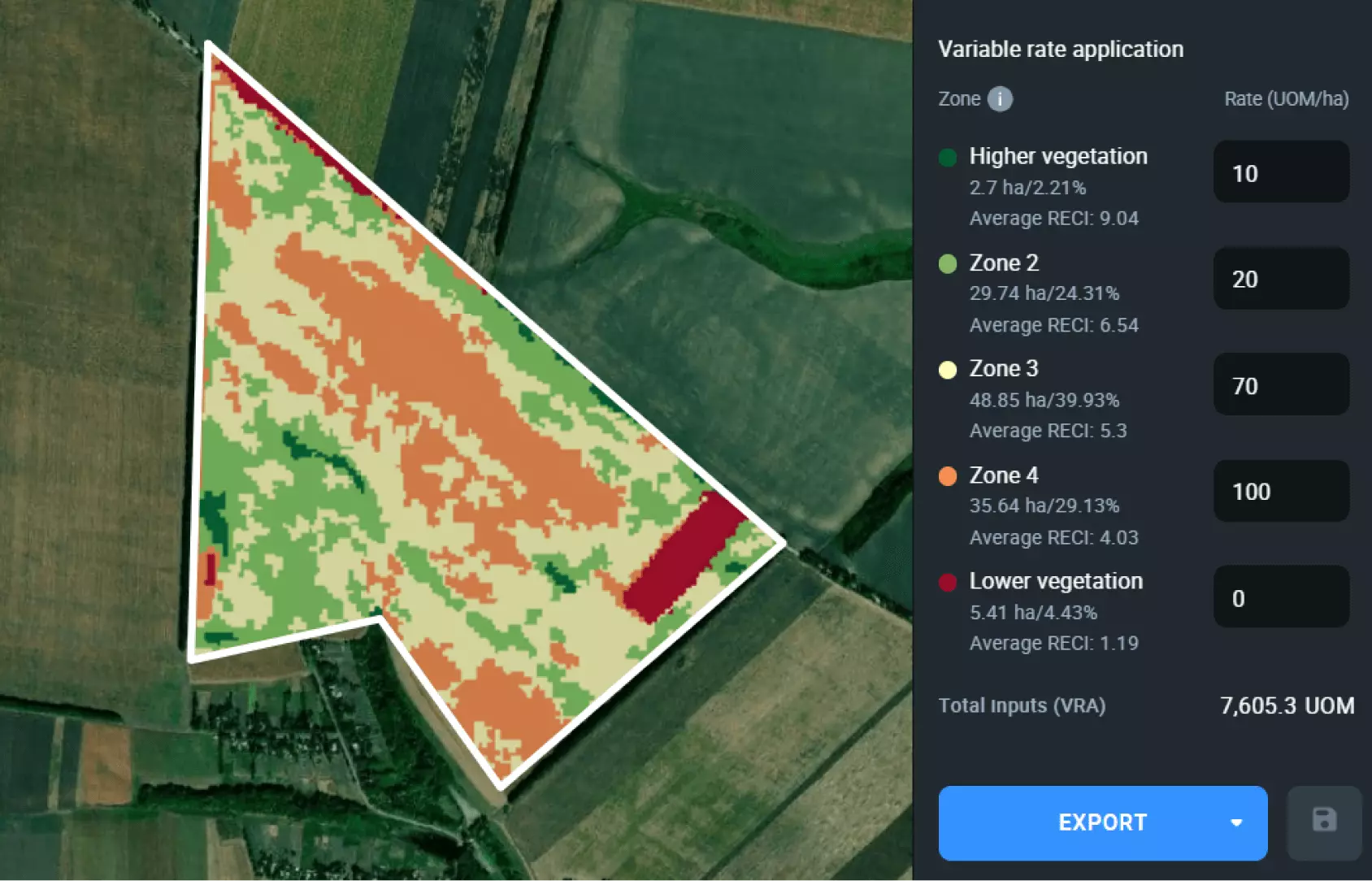
EOSDA Crop Monitoring’s Data manager and VRA maps with their advanced mapping capabilities, can also serve as valuable farm monitoring solutions for agricultural input suppliers to anticipate and track the effects of applying their products in various regions and fields. By integrating data from agricultural machinery with data from EOSDA Crop Monitoring, you may gain insight into the relationship between inputs and yields to better tailor your offerings to specific growing zones.
Smart Harvesting With Precision Agriculture Machinery
Smart harvesting, which employs agricultural machinery to lessen the demand for human labor, is one approach to the problem of insufficient workers during the busy harvest season. These agricultural machines, while running like clockwork, adapt their settings automatically to maximize the amount harvested based on crop state, atmospheric conditions, and soil quality. Smart harvesting streamlines processes and reduces resource use, both of which are essential for sustainable farming.
The use of sensors in harvesting machinery has greatly expanded their capabilities; now, they can detect grain moisture, sort harvested fruits on site, execute selective harvesting, and much more, besides simply distinguishing ripe from unripe crops. Smart agricultural machinery also benefits from the integration of satellite technology, enabling accurate estimation of the optimal harvesting period and full tracking of machine movement across vast areas.
Balance Out The Side Effects Of Employing Agricultural Machines
Agricultural machinery has transformed how farms function, providing crop producers with multiple perks such as enhanced farm management, efficiency, and productivity. At the same time, unsustainable mechanization is associated with some undesirable outcomes, including:
- greenhouse gas emissions and environmental pollution from burning fossil fuels and overuse of chemical inputs;
- soil erosion, compaction, and eventual decrease in fertility, caused by the use of heavy agricultural machinery and repetitive field passes.
Thankfully, the downsides of commercial agricultural use of machinery can be mitigated with the help of precision farming technology. Relying on dependable and affordable satellite data to guide your farm management decisions enables optimizing the application of seeds, fertilizers, pesticides, and other inputs while drastically reducing the number of machine passes and overlaps in the fields. This way, you can achieve a balance between economic benefit and environmental stewardship.
About the author:
Kateryna Sergieieva has a Ph.D. in information technologies and 15 years of experience in remote sensing. She is a Senior Scientist at EOSDA responsible for developing technologies for satellite monitoring and surface feature change detection. Kateryna is an author of over 60 scientific publications.
Recent articles

Analyze 2025 & Plan Your Best Year Yet: LandViewer Christmas Offer
It’s the most wonderful time of the year! The Christmas holidays are here, and so is your chance to analyze 2025 and plan a prosperous 2026 with more affordable Pro plans in LandViewer.

EOSDA Models Climate Change Impact On Sugarcane Yields
EOSDA modeled future temperature, rainfall, and other climate impacts on Veracruz sugarcane. The results help growers plan long-term adaptation strategies, including timing, varieties, and irrigation.

EOSDA LandViewer Black Friday Sale: Exclusive Offers & Giveaway
This Black Friday, LandViewer offers new users the chance to save on monthly plans, get extra months with yearly subscriptions, and participate in a free annual plan giveaway.